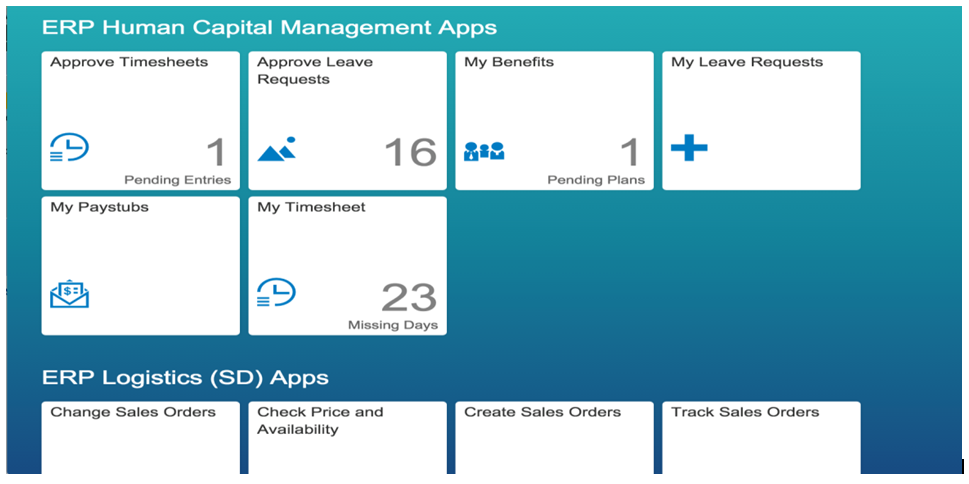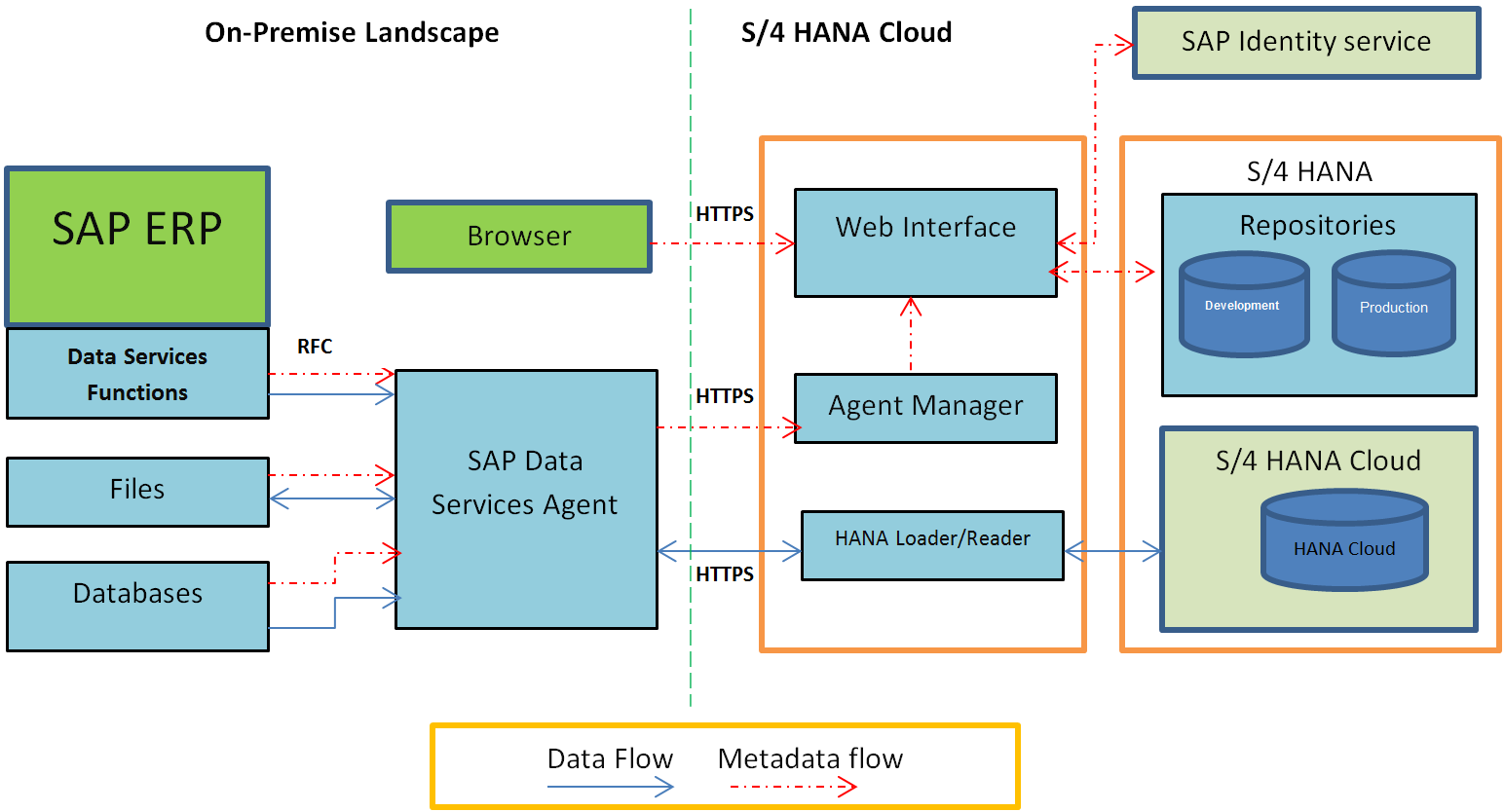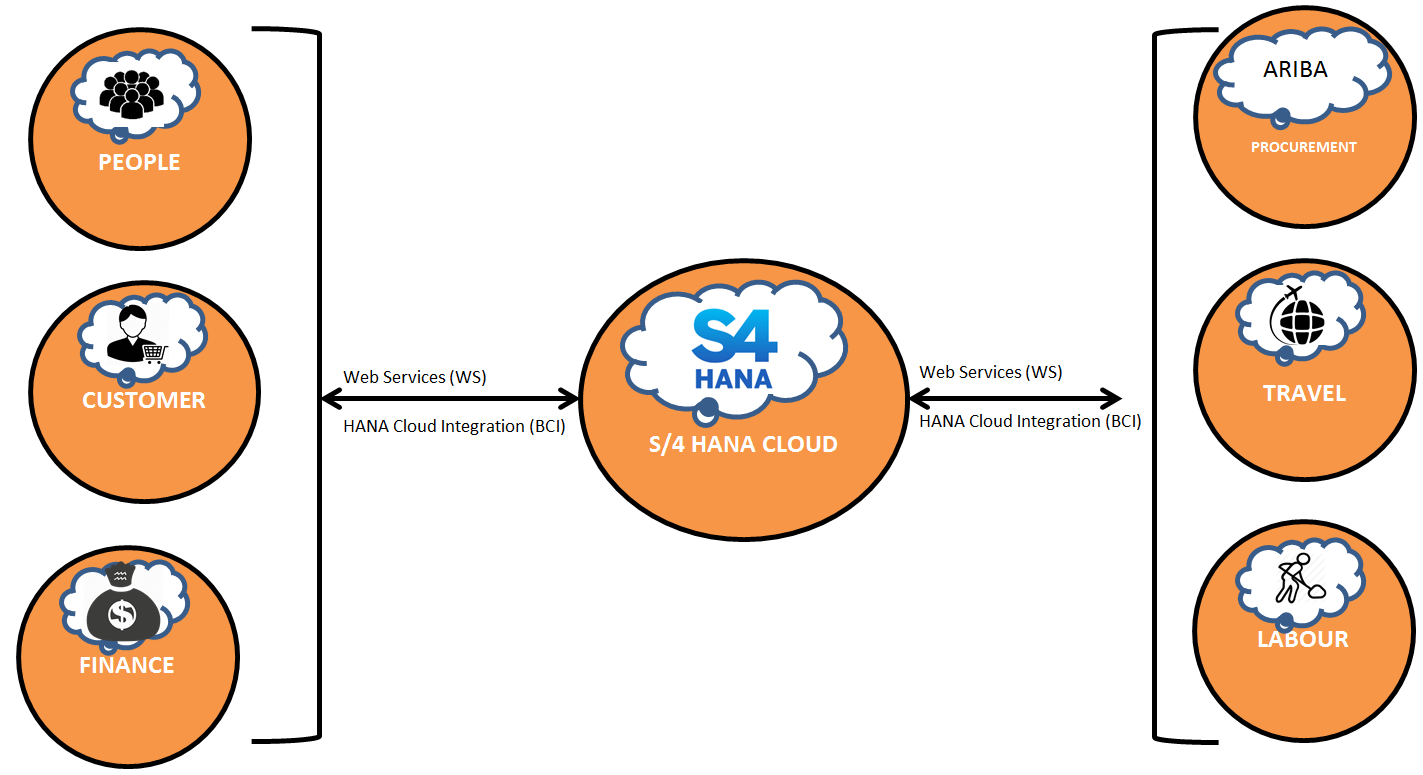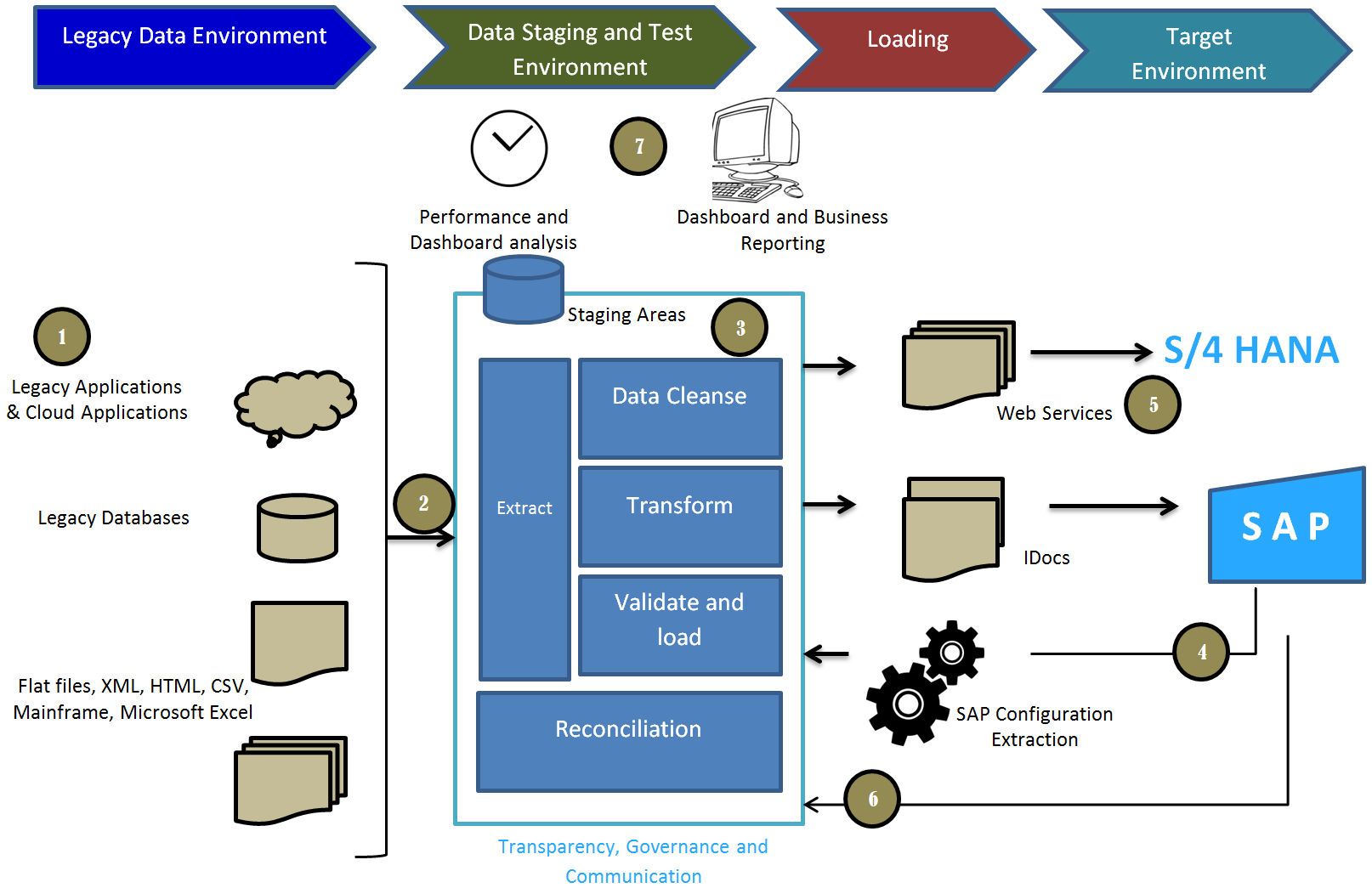-
Paper Information
- Paper Submission
-
Journal Information
- About This Journal
- Editorial Board
- Current Issue
- Archive
- Author Guidelines
- Contact Us
American Journal of Computer Architecture
2016; 3(1): 1-7
doi:10.5923/j.ajca.20160301.01

Integrating ERP Business Components into SAP S/4 HANA Cloud Edition - A Functional and Technical
Mallikarjuna R. Ghattamneni
PSCM (Procurement and Supply Chain Management) Group, Spectra Energy Corp, Houston, USA
Correspondence to: Mallikarjuna R. Ghattamneni, PSCM (Procurement and Supply Chain Management) Group, Spectra Energy Corp, Houston, USA.
| Email: |  |
Copyright © 2016 Scientific & Academic Publishing. All Rights Reserved.
This work is licensed under the Creative Commons Attribution International License (CC BY).
http://creativecommons.org/licenses/by/4.0/

In the simplest terms, cloud computing means storing and accessing data and programs over the Internet instead of your computer's hard drive. The cloud is just a metaphor for the Internet. SAP S/4HANA Cloud Platform is an in-memory cloud stage for now’s inexorably arranged, versatile, social, and information-driven world. This case study is based on a project for implementing Enterprise Management, which uses HANA database, and the project team can say that it was really a challenge. A lot of companies will face that same challenge if they want to go with SAP’s new technology i.e S/4 HANA, a brand new product with table simplification, increased user experience and real-time information within the Enterprise Management solution. In simple words, SAP is going on the right direction, but it will be a real challenge to adopt this innovation. Before explaining why that challenging, have to clarify that S/4HANA product is still improving and evolving. While several companies are wondering if it is time to move on into S/4HANA or wait? This article is all about the important factors to be consider before making the decision. Especially talking about the variables that play into the big step to move towards S/4HANA. The major variables covered in this article are broadly classified and discussed in terms of 1. Functionality, 2. Architecture and landscape, 3. Hardware, 4. Integration and customization and, 5. Change adoption.
Keywords: SAP, ERP, S/4 HANA, Cloud, On-Premise, Fiori, Mobile applications, Internet, APIs, TM, SRM, EWM, TCO and CRM
Cite this paper: Mallikarjuna R. Ghattamneni, Integrating ERP Business Components into SAP S/4 HANA Cloud Edition - A Functional and Technical, American Journal of Computer Architecture, Vol. 3 No. 1, 2016, pp. 1-7. doi: 10.5923/j.ajca.20160301.01.
Article Outline
1. Introduction
- SAP S/4HANA is the short form for “SAP Business Suite 4 (for) SAP HANA” with another code line. It brings enormous flood of SAP advancement to their clients, like the move from SAP R/2 to SAP R/3. It is SAP’s cutting edge business suite and another item completely based on the most exceptional in-memory stage today. And, as per the present-day outline standards this suite came up with SAP Fiori (Fig: 1) client experience (UX). SAP S/4HANA conveys gigantic rearrangements (client appropriation, information model, client experience, basic leadership, business procedures, and models) and developments (Internet of Things, Big Data, business systems, and versatile first). This will give organizations run straightforward in an advanced and arranged economy. SAP at present offer on-Premise, cloud (open and oversaw) and half-breed organizations to give a genuine decision to clients.
 | Figure 1. SAP Fiori User interface (UX) |
2. Strategy to Move onto S/4 HANA
- A reasonable methodology on moving to S/4HANA must be characterized, proceeding begin any undertaking or exercises to move into the most up to date SAP advancement. This procedure must be adjusted to business technique. We like the phrase read couple of days ago: “We don’t need a digital strategy - we need a business strategy for a digital world”.Recommended three situations on moving to S/4HANA:1. New implementation, also known as “green field” implementation, for companies that does not have SAP ERP core or companies willing to re-implement SAP core solution.2. System conversion, which means is not an upgrade for going to S/4HANA. As a new product system migration is possible, but consider that a lot of data transformation needs to be done.3. Landscape transformation that could include migration of selected applications or system consolidation into one S/4HANA system. This is when having several instances or different functionality in several SAP systems which need to consolidate them on S/4HANA.In scenarios 2 and 3, system upgrade is not an option. One example of migration would be converting vendors & customers into business partners. In order to do it data transformation should takes place. SAP is providing some tools for data migration and transformation, even though process validation, data analysis and data cleansing times must be considered during the project’s timeline.The fundamental challenge is to establish a business-aligned road-map to move into S/4HANA. Planning times for transition schema should be considered for all activities within to avoid operation risks and business downtimes. For any selected scenario a clear strategy should be addressed from the very beginning day of the project. To make the strategy for implementation, it will take time and resources to streamline the project scope.
3. Functionality
- For this part, make sure all the current business processes are covered by new product functionality on the new suite. There is a road map available for S/4HANA to include all ECC (Enterprise Central Component) functions which includes like APO, CRM, SRM, EWM, and TM. This is part of SAP’s simplification, also if there is a plan to expand the business or enter to new markets where you will need new business processes or new ways of doing things, you should consider a full functionality review beforehand. The good thing is S/4HANA helping you on entering to new markets or going to new business processes providing speed and some flexibility with Cloud Platform (to make extensions).System architects have to take a deep review of S/4HANA simplification list and SAP Help to check for functionality on each version. Be aware that each quarter new releases are coming for cloud edition and every year for on-premise edition.
4. System Architecture & Landscape
- Organizations should remember making sure the global architecture definitions before the start of S/4HANA implementation or conversion. Check for periodic updates on components and make sure releases on cloud edition are planned in advance, this is to avoid system failures generated by updates.Architecture is one of the big changes in S/4HANA implementations. With this new product a lot of components must be installed or activated (Application engines, Fiori, CDS, Gateway, HANA Studio, KPI modeler, OData, BW-Embedded, Analytics, etc.). These component versions are updated and enhancement packages are constantly released to make improvements on the new product. So, take into consideration of periodic checks on system and component versions, support packages and/or enhancement packages. SAP mentions that releases will not be disruptive as in predecessor technologies (R/3, ECC), but a clear strategy into that statement should be adopted by companies on sticking to standard S/4HANA processes.
 | Figure 2. S/4 HANA landscape (architecture) |
- Also when integrating to other SAP systems you could find new standard API’s (Application Programming Interface) like Success Factors - Employee Central integration to S/4HANA Human Resources, new integration tools like HANA Cloud Integration (HCI) and more. Some considerations when integrating with Non-SAP systems could affect definitions for SOA and S/4HANA integration processes.We successfully integrated below business components with S/4 HANA. Below components are remodeled into the new architecture successfully. Some going to be converted with S/4 HANA and some of the components will be merged with SAP S/4 HANA core.1. EWM, TM, and TREX: S/4 HANA search engine will replace TREX. EWM and TM are planning to move S/4 HANA core.2. BW & BI: BI will be moved to cloud as C4A (Cloud for analytics). BW – Operational reporting will be moved to S/4 HANA and BW-history reporting stays as EDW.3. PI: will be converted as PO or HANA cloud integration (HCI).4. SCM: ATP, Production planning ad detail scheduling will come to S/4 HANA. Demand planning and Supply planning will renew with IBP.5. SRM: Converts as ARIBA for business network & S/4 HANA for procurement solutions.6. CRM: Hybris & C4C (Cloud for customer) for customer interaction and sales order execution will be moved to S/4 HANA.These are the components continued AS-IS in new architecture as well:1. MDG (Master Data Governance): It will stay as a separate system as now.2. EP: Enterprise portal stays and will be integrated with UI front end server.Today as in the past, we have a classic financial document that is stored in one or two tables. However, aggregates and index tables used to be necessary, the different views have mapped to the document. Which are no longer needed in the new architecture? If the underlying data structures, we try to consolidate and simplify. For an in-memory database can work best with wide tables. Tables that have been nested earlier, you put together now. Fundamental data structures that define how a financial document, a material movement document or inventory management document look, we have constant. The evidence we have so far as possible as it is. This makes the customer the way easier of a classic ERP system to new technology. A new data structure would mean that he would have to make a complete migration. From effort forth that is similar to a system implementation. For the customer this way we have chosen is so simple, as we allow an upgrade to a new system. Briefly: The old data model was basically okay. And we can achieve so much, that we see no need to rush the customer in a disruptive process of a completely new data model with a slightly modified data model.Before your systems architecture design started, we should remember SAP S/4HANA delivers high-volume transaction processing (OLTP) and high volume real-time analytical processes (OLAP) based on a unified data model without the redundant data layers typically required by traditional RDBMS based systems. This reduces TCO (Total Cost of Ownership) while providing new opportunities to increase business value from existing architecture. Examples for redundant data layers are custom-built layers based on database tuning efforts such as secondary indexes, or application built-in performance accelerators such as aggregate tables or multiple general ledger versions for different managerial reporting needs. The massive simplifications of the data model and the data processing layers enable business and technological innovations on a broad scale across all lines-of-business and industry solutions. The new application architecture simplifies system landscape architectures and accelerates cloud deployments on an economical scale.Two distinct changes that S/4 HANA architecture offers: From the technical aspect, S/4 cuts the digital footprint of business by as much as 90%. An example of this is the reduction of the ERP table structure from 110 tables to 10 tables and removing all rollups, aggregations and updates to the non-transactional data groups. This is important, because, like watching a before-and-after episode of Hoarders, the reduction of data forces one to clean house of redundant, dated material that people like to keep because they “might” need it someday.With the newly available architectural functionalities, the business process has been rewritten. SAP rethought the architecture. In our case study, 45% of the SAP IT load is data exchange between the CRM and ERP systems. This latest architecture with multi tenancy solution put the systems together and ran one application. That is a process changer, application changer, database changer, User Interface changer and configuration changer.
5. Hardware
- The HPE ConvergedSystem for SAP HANA portfolio are optimized systems built to deliver the highest levels of performance and availability for clients’ in-memory computing initiatives. From managing analytics and data warehousing workloads to running mission-critical business applications, the HPE ConvergedSystem can help businesses unlock operational efficiencies and turn large amounts of data into real-time, actionable business insights. HPE Converged System for SAP HANA portfolio is designed to support SAP’s latest generation business suite, SAP S/4HANA.Compute Node: Optimized for SAP HANA available with a choice of Intel Xeon E7-8890v4 or Intel Xeon E7-8880v4 processors on the new, enterprise-class HPE ProLiant DL580 Gen9 Servers. The ProLiant DL580 Gen9 Server has security and data protection features for system resiliency that your business can depend on—making it ideal for mission-critical enterprise, business intelligence, and database applications.Storage: Fast, easy to use enterprise class HPE D3700 Storage array offers reliable performance for your HANA database. The external storage is optional for configurations up to and including 1 TB, but is required for configurations of 1.5 TB and larger.Operating System: SAP HANA Studio / SAP HANA SPS12+ [1], HPE Integrated Lights Out Advanced.
6. Integration and Customization
- SAP S/4HANA, cloud edition is designed for enterprises that need standardized cloud integration offerings that cover the core business scenarios and the line-of business cloud solutions. For the cloud edition, the main integration technologies are SAP HANA Cloud Integration and Web services. Based on the selected scope and subscription model, customers can leverage the fully integrated, secured, and managed SAP S/4HANA, cloud edition by SAP. In most cases, the required customer integration scenarios are provisioned, configured, and activated from SAP Cloud Operations and SAP Cloud Service Center, or SAP provides self-configuration user interfaces so customers are able to configure the solution.The deployment of extensions in the HANA Cloud Platform (HCP) is an elegant way to enhance S/4HANA systems or to build completely new applications, which referred as guided customizations. S/4HANA combines the proven set of core business functionality, in many languages and for nearly all countries, with the ability to venture into completely new dimensions of applications. This capability is key when business processes are developing at an ever increasing speed and core enterprise systems cannot just be complemented by point solutions but have to also accommodate these changes. This reduction in complexity also lowers the threshold for smaller companies to switch to S/4HANA.The current SAP S/4HANA, cloud edition already covers specific business scenarios for the marketing line of business and for the professional services industry. The enterprise edition includes: finance, accounting, controlling, procurement, sales, manufacturing, plant maintenance, project system, and product lifecycle management. The content is integrated with SAP cloud solutions such as SAP SuccessFactors Employee Central, SAP Ariba, SAP Hybris Marketing, SAP Jam, SAP Financial Services Network, and third-party integration with Vertex for tax calculation. Customization by developing code out of standard functionality is always a huge challenge and involves with budgets and resources. But for sure making customization reduction is a good recommendation so far; keep core development at minimum and non-core customizations on external applications, so when going into new versions non-disruptive adoption really happens.Recommendation is, HANA Cloud Platform has tools for code development and extensions on standard functionality, an architecture validation for customization should be driven to choose the right component for developing new code. Beforehand should not consider S/4HANA cloud edition if core development is taken as a business strategy. So S/4HANA on-premise will be the best option. So far we still recommend staying on standard processes all the way through the transition (it does not matter if there is cloud or on-premise edition).
7. Change Adoption
- Embrace change and innovation as one of the most important things on moving into S/4HANA, easy to say and very hard to apply. A lot of transformation processes fail because of people’s change resistance. With this new product not only users or business analysts must be willing to adopt change, but also consultants, IT specialists, even directors and sponsors must understand innovation and their participation as part of the business transformation. An active role is clearly needed from company’s leadership to help get things done while change is the biggest challenge of all.
 | Figure 3. Integration path of SAP S/4HANA, cloud edition to cloud solutions from SAP |
 | Figure 4. The Road to SAP S/4HANA Transition and deployment options (Numbering shows the order in which deployment takes place) |
8. Conclusions
- S/4HANA is by far the best ERP system SAP has ever offered to the market. In combination with the new customer facing applications like hybris, the SaaS applications Success Factors, Ariba, Fieldglass, Concur and the Internet of Things projects with HANA SAP offers a unique suite of products, which can be installed and activated quickly. The HANA Cloud Platform allows for easy implementations of extensions to integrate other software products or bespoke applications. As a result the new product offers a clear competitive advantage for relatively low costs. SAP saw a dramatic increase in S/4HANA projects which could otherwise benefit a lot in these days of massive changes, to make the move to S/4HANA by facing minor challenges discussed in detail.One of the reasons why companies have plans for S/4HANA is the completeness of the product. To recreate the wealth of functionality of the business suite is quite a challenge, but now financials, sales and logistics are available and most of the industry specific solutions will follow soon. SAP wants to achieve a better separation between the industries in order to reduce potential conflicts between them. Every transition case from ECC 6.0 to S/4HANA has to be evaluated individually (in terms of architecture, functionality, hardware and existing business processes). For some time there will always be a constellation, where the suite is the more complete solution for a specific client. That shouldn’t be interpreted as a weakness of S/4HANA but a compliment to the suite. Many clients choose to become familiar with HANA by moving the business warehouse onto S/4HANA or start with completely new projects in product research or service including internet of things scenarios.SAP will allow in running the new system in the cloud and on premise, but it will be only S/4HANA with which we can achieve this in one software version going forward. This will reduce the TCO and speed up the so much needed step into the future. Every single application area like data entry, standard reporting, analytics and predictions, the digital boardroom or the multi-channel customer interaction, to name a few, becomes a world class component in its own right. This alone is a reason to consider an earlier migration to S/4HANA.With the introduction given and the challenges mentioned about SAP S/4HANA implementations, one can meet the challenges of the day to day Networked Economy. Here’s how: 1. Rethink about the plan of action by streamlining your business joint effort to interface individuals, gadgets and business systems continuously (by adopting the core challenges mentioned above). Grasp high-exactness focusing on and social advertising, request driven supply chains with downstream demand visibility, smarter business arranging with constant planning and reproductions.2. Rethink about the decision making by getting insight on any data from anywhere in real time to accelerate and intensify business impacts. Connect contextual data and business users at the point of decision to discuss broadly about the challenges and how to overcome those.3. Rethink your business processes by focusing on essential tasks in real time – with the flexibility to adapt quickly. SAP S/4HANA offers a single data foundation where both transactional and analytical workloads can be executed and the gap between insights and action is closed.4. Rethink the user experience by completing the job across lines of business with a personalized, simple user experience on any device. Embed data mining and predictive tools in front-end applications. This empowers employees to make better, more informed decisions and respond to today’s real-time business challenges.Eventually for the project to be success, the following items should be clearly addressed:Ÿ Business case clearly balancing the cost of working in multiple systems against the benefitsŸ Budget for patching and regression testing source systemsŸ Clear Master Data Governance Strategy and capability planŸ Architectural and integration plan for the consolidated solution.
ACKNOWLEDGMENTS
- This case study was supported by Maria LeBeau (Director, Supply Chain Management, Spectra Energy Corporation) and Christopher Collins (Manager, ERP Legacy Systems, PSCM – Procurement and Supply Chain Management, Spectra Energy Corporation, headquarters, Houston, TX). We thank our colleagues from Spectra Energy Corporation who provided insight and expertise that greatly assisted the research, with their willingness to support all of the interpretations/conclusions of this paper.I would also like to show our gratitude to the Phillip Dunn (Manager, Compliance and SOX), Jim Ischy (Manager, MDM technologies, Spectra Energy Corporation) and Irfan Ahmed (Manager, Business Process Improvements and Implementation, Spectra Energy Corporation) for sharing their pearls of wisdom with us during the course of this case study, and we thank the reviewers Veloz Rene (Reporting Data Expert, Spectra Energy Corporation) for their so-called insights. We are also immensely grateful to Pohjonen, Antti-Jussi (Manager, Supply Chain Management, Spectra Energy Corporation) for his comments on an earlier version of the manuscript.
 Abstract
Abstract Reference
Reference Full-Text PDF
Full-Text PDF Full-text HTML
Full-text HTML